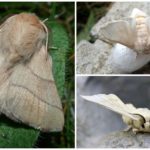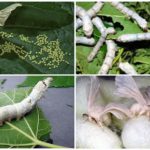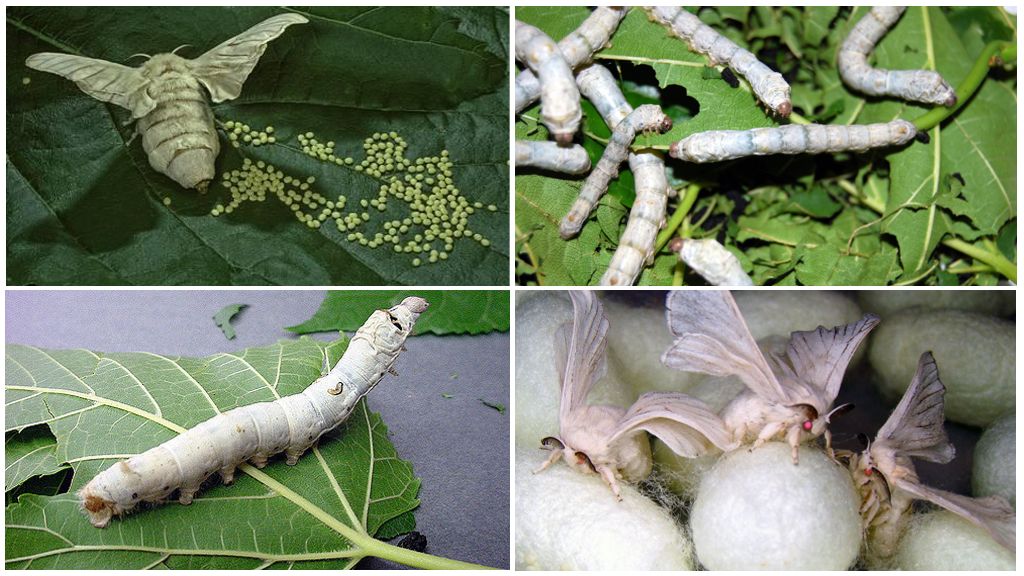Description and photo of caterpillar and silkworm butterfly
- Silkworm
- Silkworm caterpillars
The silkworm is a nondescript butterfly from the family of real silkworms, a squad of mulberry trees. Insect domesticated in China more than 3 thousand years ago, plays an important economic role in the production of natural silk, sericulture. In nature, there is a wild silkworm, which is considered a "derivative" of the home. Dwells in East Asia, China, Primorsky Krai of Russia.
Moth appearance
Butterfly silkworm fairly large size. Wingspan is 60 mm. The color is off-white with brown patches. The body is divided into segments, on the head shaggy comb antennae in males, less pronounced in females. Despite the significant size of the wings, the silkworm butterfly practically does not fly, leads a sedentary lifestyle due to domestication. The oral apparatus is underdeveloped, throughout the adult life the insect does not feed.
Interesting!
The moth of a wild silkworm is quite beautiful, the color is close to white. In size a little smaller. At home, bred for industrial purposes, hybrids with different colors - pink, brown, brown. There is also a non-hairless silkworm. However, the white moth is more appreciated.
Photo silkworm presented below. On it you can carefully consider the features of the appearance of the male butterfly, female. The life cycle of the insect includes several stages:
- egg;
- larva;
- pupa;
- imago.
The duration of development depends directly on environmental conditions, the availability of food.
Eggs
After fertilization, the female lays from 500 to 700 eggs - gren. Oval shape, elongated, flattened on the sides. The size of one egg does not exceed 1 mm in length, 0.5 mm in width. On the one hand, there is a hollow along the length of the neck, on the other hand a bulge. The color is off-white, milky, yellowish immediately after deposition, purple by the end of the maturation of the larva. If the color scheme does not change, it means the death of the embryo inside.
The ripening period of grenes is long, with a decrease in temperature, metabolic processes slow down, development stops. Laying female eggs in July and August. Development continues in early spring, when larvae emerge from the eggs. At constant high temperatures of more than +15 degrees Celsius, the larvae may appear in the same year.
Interesting!
Eggs of home silkworm are placed in a refrigerator, where the temperature is maintained from 0 to -2 degrees Celsius. Under such conditions, a strong, healthy silkworm caterpillar appears in spring. If the wintering temperature is higher, the younger generation is born weak. This is due to the fact that the caterpillar appears too early when there is not enough food for it.
Larva
Caterpillar of the silkworm resembles a white worm, before they were called so. Body elongated with head, belly, chest. On the head are placed small horns - appendages. On the inner part of the body there are 8 pairs of legs, with the help of which the silkworm larva moves along the bark of the tree, the leaves. The chitinous cover is rather dense, it performs the function of muscles. Photo silkworm caterpillar can be viewed below.
Larvae appear extremely small, no more than 1 mm in length, but with a good appetite. Feed the caterpillars only mulberry leaves, she is a mulberry tree, because of what happened the name of the insect.
The full development cycle of the caterpillar is 45 days. During this time, 4 molts occur. Until the last stage, the caterpillar grows in size up to 30 times. At the end, the caterpillar forms a cocoon of silk thread around itself, for which insects are grown. If you expand one cocoon, you get the length of the thread from 300 to 1600 m.
Interesting!
Pupa of silkworm of snow-white color. Inside the butterfly develops a few days, independently selected outside.Shortly before that, you can hear the noise, feel the movement in a cocoon.
Emergence of imago
Formed moth silkworm produces a special adhesive that can dissolve the cover of the pupa, filaments. Initially the head is shown, then the wings. For its birth, the butterfly chooses the time from 5 to 6 in the morning.
Within a few hours after birth, the mating process begins. The butterfly lives for about 20 days, but there are also long-livers who live to 45 days. The male lives half as much. The butterfly does not eat anything, it is only engaged in the reproduction of the younger generation. Even being without a head, the female does not stop this process.
Silkworms are grown specifically for the production of silk, the person regulates independently the number of insects. To obtain raw materials, moths are not allowed to appear, they are placed in conditions that are unfavorable for the development of adults.
On a note!
The silkworm does not cause harm to humans, it is not battled with it, it specifically creates favorable conditions for nutrition and development. But butterfly moth is a true pest that is being fought intensively.The insect damages about 300 species of deciduous, coniferous plants. Keep up with unpaired Siberian silkworm, destroying any coniferous trees within its range.









